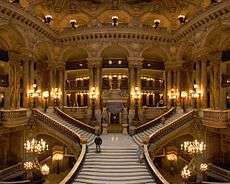Napoleon III style

The Napoleon III style is the name commonly given to a 19th-century style of Renaissance Revival architecture in France, especially in Paris. It is a sub-style of Second Empire architecture, which is a term also used elsewhere in the world for this style. It is characterized by its eclecticism, because of the mix of decorative elements from the past.
It flourished during the Second French Empire, with the patronage of Napoleon III.
Term
The term "Napoleon III style" (French: style Napoléon III) may be contemporary: legend has it that when the Empress Eugénie asked architect Charles Garnier whether the Palais Garnier, under construction in 1862, would be built in the Greek or Roman style, he replied, "It is in the Napoleon III style, Madame!"
The term is also not reserved exclusively for architecture. It is used also to describe furniture of the period, especially in the marketplace, where other "royal period" styles are commonplace.
Characteristics
The style is characterised by high façades, mansard roofs, and, more rarely, pavilions. The buildings are richly decorated but with clearly defined outlines.
The Napoleon III style is associated with the renovation of Paris under Baron Haussmann between 1852 and 1870. The buildings of the renovation show a singularity of purpose and design, a consistency of urban planning that was unusual for the period. Numerous public edifices: railway stations, the tribunal de commerce, and the Palais Garnier were constructed in the style.
See also
References
- "Second Empire style" (2008). In Encyclopædia Britannica. Retrieved 1 June 2008, from Encyclopædia Britannica Online: http://www.britannica.com/eb/article-9066516
External links
| Wikimedia Commons has media related to Second Empire architecture in France. |